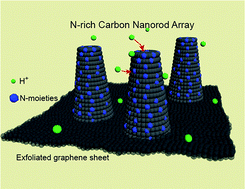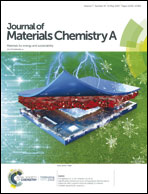Boosting the pseudocapacitance of nitrogen-rich carbon nanorod arrays for electrochemical capacitors†
Abstract
Nitrogen-doped carbons possess the merits of carbon and the unique functionalities of N-moieties, leading to vast interest for energy storage. They are generally synthesized by the pyrolysis of N-rich polymers, which however requires relatively high temperature and causes the loss of N. The pseudocapacitive contribution from N-moieties is thus limited. Here, a low-temperature pyrolysis approach is demonstrated to prepare N-rich carbon nanorod arrays. The decomposition of (NH4)2SO4 releases ammonia and allows the incorporation of N with the oxygen functional groups in polyaniline chains. The loss of N-moieties is effectively prevented at the low-temperature condition (350 °C), resulting in a high N-content of ∼21.86%. A highly conductive 3D graphite substrate is used to further enhance the charge transfer kinetics. The optimized electrode provides an excellent gravimetric capacitance (776 F g−1 at 1 A g−1), a good rate capability and a long cycle life. The low-temperature strategy demonstrated here could also be used to fabricate other doped carbon materials with high heteroatom content. Comparing with the commonly used high-temperature pyrolysis method, this efficient low-temperature strategy provides more feasibility for large-scale applications.



 Please wait while we load your content...
Please wait while we load your content...